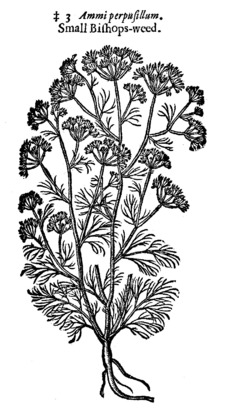
Gerard's Herbal
The Description.
1. The common Ameos, especially with us here in England, hath round green stalks, with divers boughs and branches, and large long leaves, divided into divers other narrow, long and small leaves, dented or snipped about the edges, having at the top of the stalk white flowers in great spoky tufts, which bring forth a little sharp and bitter seed: the root thereof is white and thready.
2. This excellent and aromatical Ameos of Candy hath tufts and leaves like Daucus creticus, and a root like unto the garden Carrot, of a yellow colour, and hot seed like Origanum, of an excellent spicy savour or smell, growing in spoky tufts or roundels like Carum: it hath been brought from Candy and Syria into Venice, and from Venice into France, Flanders, and England, where we have often sown it; but without doubt we have been beguiled therein by the deceitful drugmasters, who have first boiled it, or used some other false and deceitful device, to bring greater admiration unto the Venice treacle, for the confection whereof this seed is a chief and most principal ingredient.

Fig. 1486. Small Bishop's Weed (3)
3. There is another kind of Ameos, which is an herb very small and tender, having stalks a foot and a half high, very small and tender, beset with leaves like unto Dill, finely jagged, and somewhat slender; and at the top of the stalks grow little tufts or spoky white roundels, which afterwards do turn into small grey seed, hot and sharp in taste. The root is small and slender.
The Place.
These plants do all grow in my garden, except Ammi creticum, whereof hath been sufficiently spoken in the description.
The Time.
They flower in June and July, and yield their seed in the end of August.
The Names.
The Greeks and Latins call it Ammi: divers call it Cuminum ęthiopicum; others, Cuminum regium, or Cumin Royal: in shops, Ammios, or Ameos in the genitive case: the Germans, Amey: in English, Ameos, or Ammi: of some, Herb-William, Bull-Wort, and Bishop's-weed.
The Temperature.
The seed of Ameos is hot and dry in the later end of the third degree.
The Virtues.
A. It availeth against gripings of the belly, in making of urine, against the bitings of serpents taken in wine, and also it bringeth down the flowers: being applied with honey it taketh away black and blue spots which come of stripes: the seed of Sison doth also the like, for it is hot and dry, and that in the third degree; likewise of thin parts, provoking urine, arid bringing down the desired sickness.
B. The seed of Ameos is good to be drunken in wine against the biting of all manner of beasts, and hath power against all manner of poison & pestilent fevers, or the plague, and is used in the correcting of Cantharides, whereby those flies are made medicinable to be applied to the body without danger.
C. Ameos brayed and mingled with honey scattereth congealed blood, and putteth away black and blue marks which come by stripes or falls, if it be applied thereto in manner of a plaster.